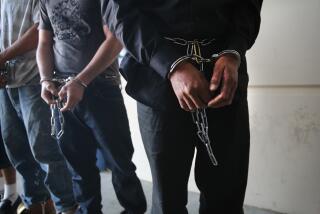State National Guard Wants to Join Drug War on U.S.-Mexico Border
- Share via
SAN DIEGO — The California National Guard, seeking to bolster its role in drug interdiction efforts, outlined plans Tuesday for the deployment of a battalion of almost three dozen military helicopters and other aircraft along the U.S.-Mexico border in San Diego.
The aircraft--which would be based at a new facility at Brown Field, less than a mile from the international boundary--would be used to identify and track drug-ferrying aircraft, although arrests would be made by civilian agencies such as the U.S. Customs Service because U.S. law limits military involvement in civilian law enforcement.
The National Guard plan, if approved by federal officials, would appear to be the most concentrated use of U.S. military might ever in a drug-combatting effort along the border. The guard units would be unarmed and would not be deployed against the movement of illegal aliens, officials said.
However, the plan, while detailed, still faces numerous obstacles on funding and other issues before being implemented. Congress may also opt to have hearings on the proposal, a congressional aide noted.
Officials have periodically called for the deployment of U.S. troops and military materiel along the border, both to deter illegal immigration and drug traffic, but the Pentagon’s involvement to date has been largely limited to the sharing of radar, intelligence data and some equipment in a drug-fighting capacity. Many military officials have been wary of increased involvement, but California National Guard authorities seem eager to heighten their presence.
“Our position all along has been that the border should have priority” in the allocation of military aircraft, said Col. Ronald A. Kludt, chief of emergency plans and operations for the California National Guard who described the guard’s proposal during a state Senate hearing in the border community of San Ysidro.
However, observers said the plan may face an uphill battle for approval in the Pentagon and on Capitol Hill because of budgetary concerns and military hesitancy. Congress would have to appropriate money or reassign existing funds to pay for the estimated $30 million in initial construction and start-up costs.
U.S. military officials have expressed fears that an increased commitment to the drug battle could result in a lessening of defense preparedness and a blurring of military and civilian roles. In addition, a congressional aide working on the project noted that the more than $400 million worth of aircraft would have to be reassigned from military deployment or from National Guard units in other states whose lawmakers might object.
The proposal is “in channels” at the National Guard Bureau, which coordinates guard activity nationwide, said Maj. Robert Dunlap, a spokesman in Washington.
The guard is calling for the construction of an armory and helicopter maintenance facility on a 40-acre site at Brown Field, which is used largely for private and cargo aircraft.
At the site, the guard would deploy 34 helicopters, including 18 Apache AH-64A attack aircraft and four UH-60 Black Hawks. The guard would also like to equip some existing Air National Guard C-130 transport planes with more sophisticated radar. Although concentrating on drug interdiction, the aircraft could also be called on for search-and-rescue operations and other tasks, officials said.
This would not be the guard’s first experience along the border. In August, as many as 100 armed National Guard military police officers participated in a 20-day pilot program, assisting Customs officers in the searching of commercial cargo in Texas and Arizona. The California proposal, however, involves a permanent guard air base.
More to Read
Sign up for Essential California
The most important California stories and recommendations in your inbox every morning.
You may occasionally receive promotional content from the Los Angeles Times.










